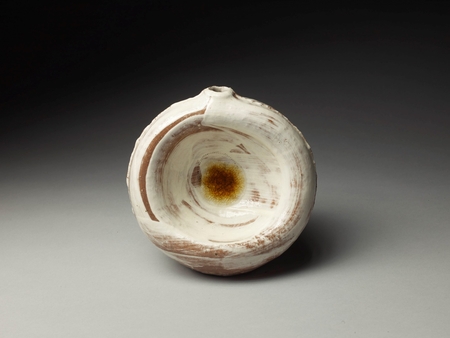Product Description
7562 Kazuo Yagi (1918 – 1979)
A flattened circular ceramic vessel decorated in white slip with a brown glaze
Seal on the base
Kiwamebako (Wood box with attestation by the artist’s family) inscribed:
Lid: Henko (flattened vase) with seal
Lid interior: Yagi Kazuo saku (made by Yagi Kazuo), Akira kan (attested by Akira), sealed Akira*
Japan, 20th century, Shōwa period
Dimensions: H. 15cm x W. 15.5cm x D. 12.5cm (6” x 6¼” x 5”)
*This work was attested by Akira Yagi (b. 1955), a ceramic artist and son of Kazuo Yagi.
Kazuo Yagi was born in Kyoto as the son of ceramic artist Isso Yagi (1894-1973). He studied sculpture at Kyoto City University of Arts and then ceramics at Shokosho Tojiki Shikenjo (Ceramic Institution of the Ministry of Commerce and Industry). From 1937 Yagi joined Nihon Tocho kyokai (Japan Ceramic Sculpture Association) and started exhibiting work at exhibitions including the Nitten (The Japan Fine Art Exhibition). In 1948 along with two other like-minded potters Osamu Suzuki (1926-2001) and Hikaru Yamada (1923-2001), he founded the influential avant-garde ceramic group, Sōdeisha (Crawling through Mud Association), a name which refers to a Chinese term meaning ‘glazing flaw’. In 1973 he was awarded the Golden Prize of Japan Ceramic Society.
Yagi is one of the pioneers of new ceramic movements, being one of the first to incorporate inspiration from Western art into practical Japanese vessels. From the mid-1950s his ceramic work became less practical and more sculptural and was referred to as Objet-yaki (Ceramic Art Object), this new concept was starkly different from traditional Japanese ceramic vessels. A perfect example being, Zamuza-shi no sanpo (Mr Samsa’s Walk), a cylindrical work with the mouth closed and added tubular decorations, first exhibited in 1954 and now in private collection is regarded as a pivotal work in the history of Japanese ceramics. Although he brought new perspective to the ceramic world, he continued to honour the tradition of Japanese ceramics, making tea ceremony ware along with more avant-garde object works. With or without utility, Yagi’s work shows the artist’s creativity backed by his wit and humour.
Selected exhibitions:
1950 Japon : Céramique Contemporaine, Musée Cernuschi, Paris, November 1950 – February 1951
1951 Contemporary Japanese Ceramics, Museo Internazionale delle Ceramiche, Faenza
1954 Genbi-ten (Modern art exhibition), Kyoto City Museum
1959 2nd International Ceramics Exhibition, Ostend, Belgium (winning a grand prize)
1959 Gendai Nihon no Togei (Contemporary Japanese Ceramic Art), National Museum of Modern Art, Tokyo
1961 Kyoto-Paris Kokan Togei, Kyoto Municipal Museum of Art, Musée national de céramique Sèvres, Sèvres, France
1962 3rd International Ceramics Exhibition, Prague, Czechoslovakia (winning a grand prize)
1963 Survey of Contemporary Japan Ceramics, National Museum of Modern Art, Kyoto
1964 Gendai Nihon no Togei (Contemporary Japanese Ceramic Art), The National Museum of Modern Art, Kyoto
1965 New Japanese Painting and Sculpture, San Francisco Museum of Modern Art, USA
1966 1st Japan Art Festival, New York, Chicago, Pittsburgh and San Francisco, USA
1968 The New Generation of Contemporary Ceramics, National Museums of Modern Art, Tokyo and Kyoto
1970 Contemporary Ceramics: Europe and Japan, National Museum of Modern Art, Tokyo and Kyoto
1971 Contemporary Ceramics: the U.S., Canada, Mexico and Japan, National Museums of Modern Art, Kyoto and Tokyo
1976 Japanese Ceramic Masterpieces, Rostock and Dresden, Germany
1977 Japanese Contemporary Masterpieces, National Museum of Modern Art, Tokyo
Celebrating Thirty Years of Sodeisha Exhibition, Kyoto Municipal Museum of Art, Kyoto
1993-94 Modern Japanese Ceramics in American Collections, Japan Society, New York; New Orleans Museum of Art, New Orleans; Honolulu Academy of Art, Honolulu
2003 Isamu Noguchi and Modern Japanese Ceramics: A Close Embrace of the Earth, Arthur M. Sackler Gallery, Smithsonian Institution, Washington D.C.; Japan Society, New York; National Japanese American Museum, Los Angeles
2005-07 Contemporary Clay: Japanese Ceramics for the New Century, Museum of Fine Arts, Boston; Japan Society, New York
2008 Modern Ceramic Art from an International Perspective, Aichi Prefectural Ceramic Museum
2014-16 Into the Fold: Contemporary Japanese Ceramics from Horvitz Collection, Samuel P. Harn Museum of Art, University of Florida, Gainesville
2015 Ancient to Modern – Japanese Contemporary Ceramics and their Sources, San Antonio Museum of Art, Texas
Unfolding Worlds: Japanese Screens and Contemporary Ceramics from the Gitter Yelen Collection, Houston Museum of Fine Arts, Houston
Works by the artist can be found in the collections of many museums including: Victoria and Albert Museum, London; Museum of Modern Art, New York; Metropolitan Museum of Art, New York; Museum of Fine Arts, Boston; Freer Sackler, Washington; San Francisco Museum of Modern Art; Minneapolis Institute of Arts; Museo Internazionale delle Ceramiche, Faenza, Italy; The National Museum of Modern Art, Tokyo; The National Museum of Modern Art, Kyoto; National Museum of Art, Osaka; Suntory Museum of Art, Tokyo; Hyogo Prefectural Museum of Art; Hiroshima Prefectural Art Museum; Niigata Prefectural Museum of Modern Art; Kyoto Municipal Museum of Art; Aichi Prefectural Ceramic Museum; Mie Prefectural Art Museum; Museum of Modern Art, Wakayama; Museum of Modern Ceramic Art, Gifu.












